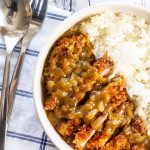Chicken Katsu Curry
Make Katsu Curry at home with tender breaded chicken or pork cutlets coated in perfectly crisp fried panko crumbs with a creamy umami Japanese curry sauce.
Servings: 2 people
Calories: 788kcal
Ingredients
- 150 ml Vegetable oil. To fill a frying pan with 0.5cm or ¼ inch.
- 1 medium onion finely chopped
- 1 medium carrot sliced
- 300 ml water (approx. check the packet instructions) (Note 1)
- 2 chicken breasts or pork loin steaks approx 150g or 5 oz each (Note 2)
- 30 g plain or all-purpose flour (Note 3)
- 1 tsp smoked paprika (Note 4)
- ¼ tsp onion powder
- ¼ tsp garlic powder
- ¼ tsp mustard powder
- ¼ tsp white pepper
- 1 tsp sea or kosher salt
- 1 egg
- 100 g panko breadcrumbs (Note 5)
- 2 portions of katsu curry roux cubes (Note 6)
- ½ tbsp honey (Note 7)
Instructions
- Place a frying pan on a medium heat and add 1 tablespoon of oil and fry the onions for a few minutes until they are translucent. Then add the carrot slices and fry for a few more minutes.
- Add the water, bring it to boil, then simmer on a low heat for 10 minutes.
- Meanwhile, prepare the chicken or pork cutlets. Cut off the fat and tenderise them by pounding them with a meat tenderiser. (Note 8)
- Mix the flour, paprika, onion powder, garlic powder, mustard powder, white pepper and salt in a bowl.
- Crack the egg into another bowl and beat.
- Place the panko breadcrumbs in a third bowl.
- Place each piece of chicken or pork into the flour until coated, then dunk them in the beaten egg and finally place them in the panko breadcrumbs until they are covered.
- By now the sauce should have simmered for 10 minutes. Add the curry roux cubes and stir until it thickens and add the honey. Leave the sauce on a low heat until it is ready to serve.
- Place a frying pan on a high heat and fill with 0.5cm or ¼ inch of vegetable oil.
- When the oil is hot, place the prepped meat cutlets into the pan and fry for 2 minutes on each side. (Note 9)
- Place them onto a wire rack or board when done. (Note 10)
- Slice cooked chicken or pork and place on top of the rice and spoon the katsu sauce on top.
Notes
- Water: The amount of water required may vary depending on the brand of curry cubes you use. Make sure you read the packet instructions.
- Chicken or pork: Traditionally, katsu curry is made with breaded pork cutlets, but chicken breast is a great alternative. Chicken breast has a firmer texture than thighs, which results in a more tender crisper cutlet, but you can use thighs instead. Loin is the pork cut of choice because its leanness enables it to cook evenly and quickly, but pork tenderloin and sirloin will also work well.
- Plain or all-purpose flour: Switch for gluten-free flour for a gluten-free option.
- Seasoning the flour: Adds flavour to the meat before you cook it. I like to add a variety of seasonings including smoked paprika, mustard powder, onion powder, garlic powder, white pepper ,and salt. If you don't have all these, you could omit a couple and it will still taste good.
- Panko Breadcrumbs: These should be available in your local supermarket. If not, an Asian grocery store will stock them. You can also use normal breadcrumbs. The pork katsu won't be as crispy but it will still taste really good.
- Curry Roux: Consist of a concentrated mixture of spices, flour, and fat that are used to make Japanese curry sauce. They are the most convenient way to make curry sauce and are dissolved in hot liquid to create a thick and flavourful curry sauce. Golden Curry cubes are the most commonly found. Some mainstream supermarkets like Sainsbury's and Ocado now stock them, otherwise, you should be able to find curry roux in your local supermarket or Asian grocery store. To make katsu curry sauce without curry cubes check out my 25 minute katsu sauce recipe.
- Honey: Substitute with sugar.
- Tenderising the meat: If you do not have a meat tenderiser you can use a rolling pin instead. Put the meat into a plastic bag first for hygiene reasons.
- Check the oil is hot: Drop a breadcrumb into the pan. If it floats and sizzles you can start frying, but if it sinks you will need to wait a while longer. You can also use a frying thermometer to check the oil has reached 180°C or 350°F.
- Meat doneness: Check by cuting into one of the cooked chicken or pork cutlets with a sharp knife to check the meat is white. If it is red it is not done and will need to go back into the pan. You can also use a meat thermometer to check the temperature. Cooked pork should be 158°F or 70°C and cooked chicken 165°F or 75°C.
Nutrition
Serving: 1g | Calories: 788kcal | Carbohydrates: 69g | Protein: 62g | Fat: 12g | Saturated Fat: 3g | Polyunsaturated Fat: 3g | Monounsaturated Fat: 3g | Trans Fat: 0.04g | Cholesterol: 226mg | Sodium: 765mg | Potassium: 1213mg | Fiber: 5g | Sugar: 12g | Vitamin A: 5783IU | Vitamin C: 9mg | Calcium: 168mg | Iron: 5mg
